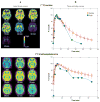Addiction circuitry in the human brain
- PMID: 21961707
- PMCID: PMC3477468
- DOI: 10.1146/annurev-pharmtox-010611-134625
Addiction circuitry in the human brain
Abstract
A major challenge in understanding substance-use disorders lies in uncovering why some individuals become addicted when exposed to drugs, whereas others do not. Although genetic, developmental, and environmental factors are recognized as major contributors to a person's risk of becoming addicted, the neurobiological processes that underlie this vulnerability are still poorly understood. Imaging studies suggest that individual variations in key dopamine-modulated brain circuits, including circuits involved in reward, memory, executive function, and motivation, contribute to some of the differences in addiction vulnerability. A better understanding of the main circuits affected by chronic drug use and the influence of social stressors, developmental trajectories, and genetic background on these circuits is bound to lead to a better understanding of addiction and to more effective strategies for the prevention and treatment of substance-use disorders.
Figures




References
Publication types
MeSH terms
Substances
Grants and funding
LinkOut - more resources
Full Text Sources
Medical

